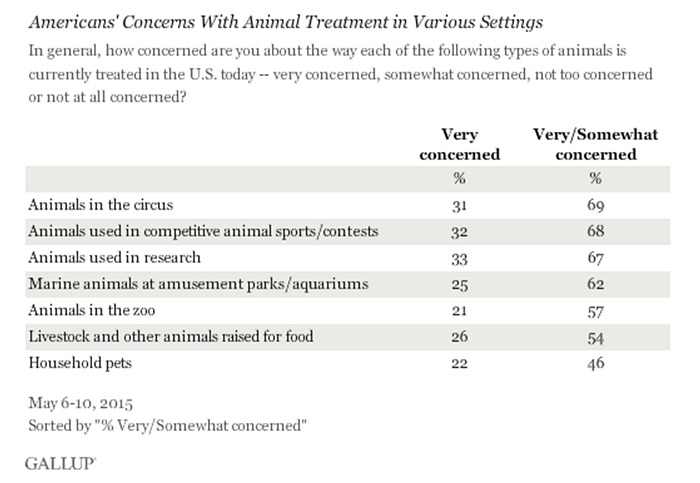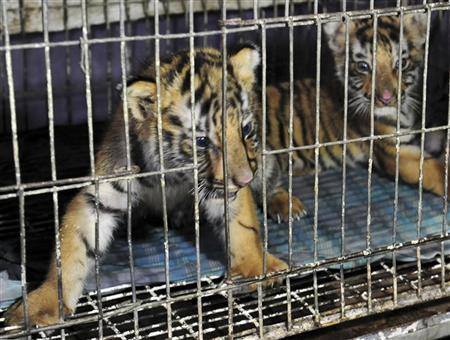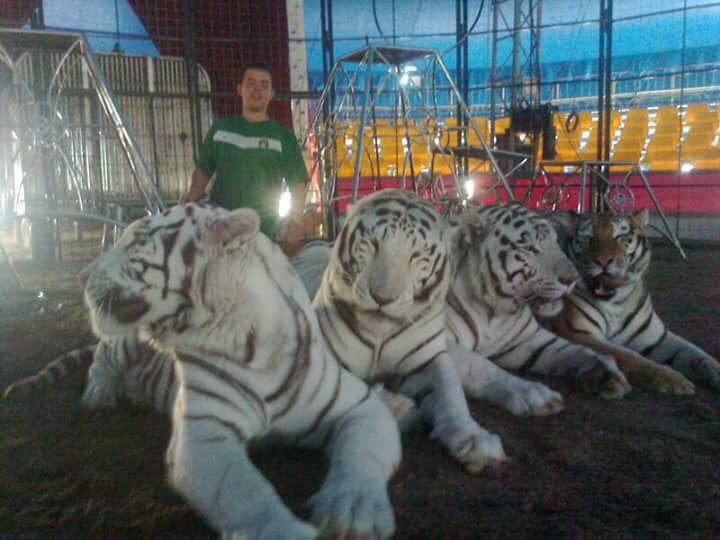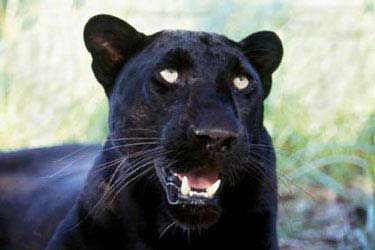CircusVSzoo
Are Zoos as Bad as Circuses?
That’s a question people usually ask me, or some variation on it, such as, “Aren’t zoos better than circuses?” I’m always surprised that some people who absolutely hate the circus will try to justify zoos.
Gallup first asked Americans about the rights of animals in 2003 and repeated the question in 2008 and again in the latest May 6-10, 2015, poll.
The 2015 results:
69 percent of Americans are concerned about animals in circuses.
57 percent are concerned about animals in zoos.
3 percent are not concerned at all about how animals are treated, meaning that 97 percent of Americans are concerned about how animals are used to some degree or another.

Keep in mind that this is a poll of Americans who are at the bottom of the list of countries who care about wild animal welfare according to this IFAW report:
Here is a roundup of circus animal bans around the world:
Nationwide ban on all animals in circuses: Cyprus, Greece, Malta, and Bolivia
Nationwide ban on the use of wild animals in circuses: Austria, Bosnia and Herzegovina, Croatia, Slovenia, Colombia, Costa Rica, El Salvador, Panama, Paraguay, Peru, Singapore, Israel and Mexico
Nationwide ban on the use of most wild animals in circuses: Belgium, Bulgaria, and The Netherlands
Nationwide ban on the use of certain species in circuses: Czech Republic, Denmark, Finland, Portugal, Sweden, and India
Nationwide ban on the use of native wild animals in circuses: Ecuador
Nationwide ban on the use of wild-born animals in circuses: Estonia, Hungary, and Poland
Local bans on the use of animals in circuses: Ireland, Norway, Spain, UK, USA, Canada, Argentina, Brazil, Chile, and Australia
At the bottom of this list is the US
BCR’s Experience with Zoo Cats vs Circus Cats
 Don’t get me wrong. I believe it is morally and ethically wrong to breed cats for life in cages. Wild cats, domestic cats; it doesn’t matter. They are hard wired to be master of their domain and there is no excuse for breeding them for life in prison.
Don’t get me wrong. I believe it is morally and ethically wrong to breed cats for life in cages. Wild cats, domestic cats; it doesn’t matter. They are hard wired to be master of their domain and there is no excuse for breeding them for life in prison.
That being said, I always assumed that circus life was probably worse for cats because they cannot be reliably trained to do stupid pet tricks in exchange for nothing but rewards. Animal abusers who make their living, or create their illusion of being special, have to resort to cruel acts against the cats in order to force them to perform on cue. Cats will work for a reward…but only when they want to and there is no amount of cajoling them that will convince them to perform when they don’t.
We do “operant conditioning” at Big Cat Rescue to try and get the cats to take their meds or to move them, but if you spend any time watching our live feeds, you can see that the cats often make us wait until they are ready, which can be hours, or days. If the “show must go on” that kind of reward training doesn’t work.
Zoo life, by comparison, seems to lack the outright cruelty involved in being shocked with cattle prods behind closed gates, or beaten and choked to make them compliant. You can imagine my surprise when we brought in 18 tigers, a leopard and an ocelot from the circus and discovered something shocking:
Cats from the circus lived longer than cats in zoos.
How could that be?
There are a few things that seem to contribute to the odd finding that cats in zoos typically live to be 10 or 12 whereas most of the cats who came here from the circus were 15 or older when they arrived. Here they are in the order that seem to have the most relevance.
- Zoos don’t want ragged looking cats on display. When an exotic cat gets to be about 12 it’s about the same as a human who is 72 years old. Their backbones start to protrude. Their muscle mass diminishes and they have that sunken, starving look, even though they may be eating well for their activity level. They sleep most of the time. They begin to have dental issues, arthritis, cataracts and all of the things that go along with getting old. A circus may continue to use a cat who can still be beaten or intimidated with electric cattle prods because the public won’t notice the condition of the animal so much if there is a lot of glitz, loud music and action.
- The bigger zoos do annual medicals on their animals, that require sedation. Every time a big cat is sedated they are endangered because they don’t deal well with the drugs and will often die during or just after being sedated. Circuses train the animals to do the things necessary to evaluate their health, such as to present their paws, open their mouths, and some will even allow a blood draw from their tails. Much of the circus cat’s health can be evaluated without sedation, which may spare them an earlier demise.
- Most zoos lock their exotic cats up in “night houses” when the zoo is not open to the public. So, from roughly 5PM until 9AM (16 hours a day) the cats are locked up in minimum sized jail cells with no windows. This is when cats would ordinarily be the most active. All the cats can do is pace endlessly; two strides up, two strides back. If you ever get a chance to see the night houses of a zoo, look at the longest wall of the cell and you will see the paint worn away from the cat constantly pacing. In their outdoor yards you will see the tell tale path, along their longest unobstructed wall, where they try to pace away their boredom and frustration. Circus cats may actually fare worse, when it comes to space, but they have something to do. Whether they are trying to avoid being attacked by another cat in the show, or the trainer, they are always on the alert and always thinking. While it would seem that this sort of fight or flight stress is worse than boredom; it doesn’t seem to be the case for cats.
Millenials Are More Enlightened
One of the most encouraging statements I’ve seen about the abandonment of archaic practices that enslave and torture wild animals was in 2016 when Buenos Aires announced they are closing down their 140-year-old zoo, arguing that keeping wild animals in captivity and on display is degrading. Mayor Horacio Rodríguez Larreta said that the zoo’s 2,500 animals will be gradually moved to nature reserves in Argentina which can provide a more suitable environment. The 44-acre zoo in the Palermo neighborhood will become an eco-park when it is reopened later this year.
“The most important thing is breaking with the model of captivity and exhibition,” animal rights lawyer Gerardo Biglia, a long-time campaigner for the closure of this city’s zoo, said in statements to the press. “I think there is a change coming for which we are already prepared because kids nowadays consider it obvious that it’s wrong for animals to be caged.”
It has certainly been our experience that it is the older generations who are most adamantly clinging to the abusive and ignorant ways of the past. Sadly, the people in authority are often these older people who were raised believing that animals don’t have feelings and that they serve no other purpose than those we devise for them. Educating them has often come through their children, who seem to just get that we have to treat animals with respect, if we are ever going to have peace.
Can We Really Change the World?
 Yes, it’s changing for the better already as more and more countries ban circus acts that use big cats. It’s changing for the better as more states pass bans on the private possession of wild cats. It’s changing for the better as more people refuse to pay to see cubs on display or exotic cats in cages.
Yes, it’s changing for the better already as more and more countries ban circus acts that use big cats. It’s changing for the better as more states pass bans on the private possession of wild cats. It’s changing for the better as more people refuse to pay to see cubs on display or exotic cats in cages.
Change is needed.
Change is coming.
Be the change you want to see in the world and help pass the Big Cat Public Safety Act.







